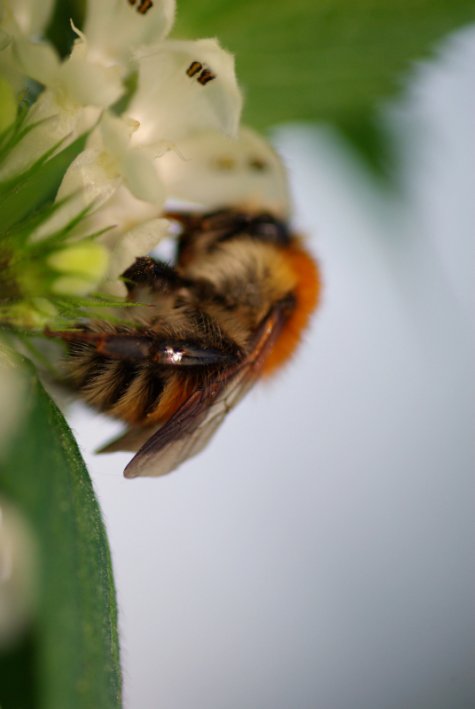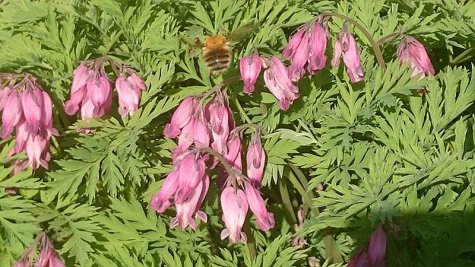All brown and rare bumblebees
Text Eha Kruus
Photos Eha Kruus and Marek Väljataga
Translation: Liis
-- Schrencki kimalane Bombus schrencki
Moss carder bee Samblakimalane Bombus muscorum
Brown-banded carder bee Jaanikimalane Bombus humilis
-- -- Bombus laesus
Since we do not have a complete picture of what areas one or the other rare bumblebee species inhabit, new information about finds is extremely valuable. The definite or probable occurrence of a brown species, confusingly similar, the claimed identification must be extremely prudently done. Because the characteristics are less well developed on smaller individuals, it can be very complicated to identify unambiguously the scarcer related species in habitats overlapping each other.
Simplest to recognize is probably the Bombus schrencki, the back of whose thorax is covered by uniformly bright, orange-brown hairs, lighter on the belly side and abdomen. On the segments of the abdomen densely hairy areas alternate with sparingly hairy ones where the black chitin shell shines through. Because of this the abdomen looks banded in yellow and black. To separate it from other brown species we must inspect the sides of its abdomen: Bombus schrenki has dark hairs on the third, fourth as well as fifth segment, while the often seen common carder bee (Bombus pascorum) has dark hairs only until the fourth segment and the tip of the abdomen is covered by light hairs; the moss carder bee and brown-banded carder bee have dark hairs only at the very end of the abdomen on the sixth segment. The B.schrenki is held to be an exceptionally good pollinator of leguminous, mint (Lamiaceae) and orchid (Orchidaceae) family plants in forests and forest verges.
The moss carder bee (B. muscorum) has a similar bright-yellowish scruff of the neck. Its abdomen too seems regularly banded in yellow and black due to the black chitin shell that is visible through the more sparse hairs in the front of the segments although the upper side of the body is only covered by yellow hairs. On the second segment of the abdomen of the brown-banded bumblebee (B. humilis) runs a broad yellowish-brown band which in a narrower shape may also repeat on the front edge of the third segment but the fourth and fifth segments are already visibly lighter. The moss carder bee is larger and brighter coloured than the brown-banded carder bee, the brown-banded carder bee again lighter than the moss carder bee. The abdomen of the moss carder bee is trapeze-shaped, that of the brown-banded carder bee triangular. The colour of the hairs in the face, underbelly and thigh part of the hind legs may vary with subspecies from black to greyish white. On the few specimens that I have seen these parts have been yellow; yellow and black hairs are mixed only on the thighs and shanks of the moss carder bee .
The preferred habitats also differ: the brown-banded bumblebee chooses drier flower-rich meadows and pastures not intensely used by cattle, whereas the moss carder bee likes boggier areas or trenched hayfields where its forage plant is clover flowering on permanently trodden paths. On shore meadows the two species may meet.
B. laesus differs by the dark spot on the thorax between the wings. The abdomen is uniformly yellowish-brown without black hairs until the fifth segment. It resembles the dark varieties of the moss carder bee so much that even specialists have not managed to secure the differences between females of the species, and identify the species by the genitalia of the males. We can however attempt to measure the proportions of the face in profile: the length of the cheek of B. laesus (a theoretical straight line from under the composite eye to the upper corner of the attachment point of the jaws) is a little shorter than the width of the base of the jaw, whereas with the Schrenck’s bumblebee and the brown-banded carder bee and moss carder bee it is a little longer and on the common carder bee much longer. B. laesus can be looked for in mainland meadows, clearings in dry pine forests and flowering alfalfa fields, where it has been the dominating bumblebee species for instance in Central Russia.
Join the „Meie kimalased – Our bumblebees” group on facebook: LINK
and share your pictures of the bumblebees in your garden with other enthusiasts!
Bombus schrencki










